Economics For Managers
VerifiedAdded on 2023/04/21
|17
|4095
|370
AI Summary
This document provides an overview of the recent trend in the Australian tourism industry, including investment projects and factors driving investment. It also discusses the impact of specific taxes on buyers in the hotel accommodation market and the overall contribution of the tourism industry to the Australian economy.
Contribute Materials
Your contribution can guide someone’s learning journey. Share your
documents today.
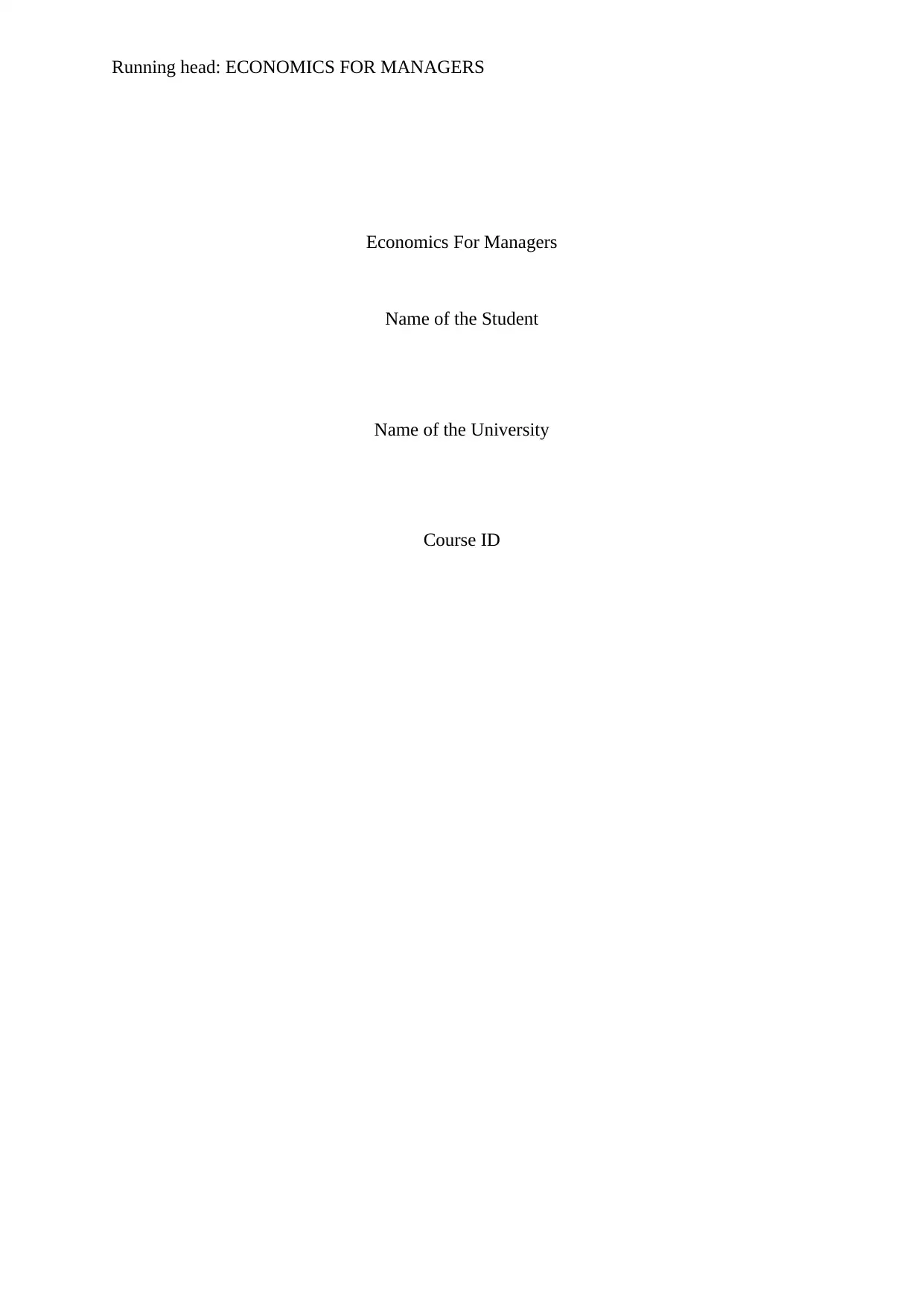
Running head: ECONOMICS FOR MANAGERS
Economics For Managers
Name of the Student
Name of the University
Course ID
Economics For Managers
Name of the Student
Name of the University
Course ID
Secure Best Marks with AI Grader
Need help grading? Try our AI Grader for instant feedback on your assignments.

1ECONOMICS FOR MANAGERS
Table of Contents
Question 1..................................................................................................................................2
Question 2..................................................................................................................................5
Question a...............................................................................................................................5
Question b..............................................................................................................................6
Question c...............................................................................................................................6
Question 3..................................................................................................................................6
Question 4................................................................................................................................10
Reference list............................................................................................................................13
Table of Contents
Question 1..................................................................................................................................2
Question 2..................................................................................................................................5
Question a...............................................................................................................................5
Question b..............................................................................................................................6
Question c...............................................................................................................................6
Question 3..................................................................................................................................6
Question 4................................................................................................................................10
Reference list............................................................................................................................13
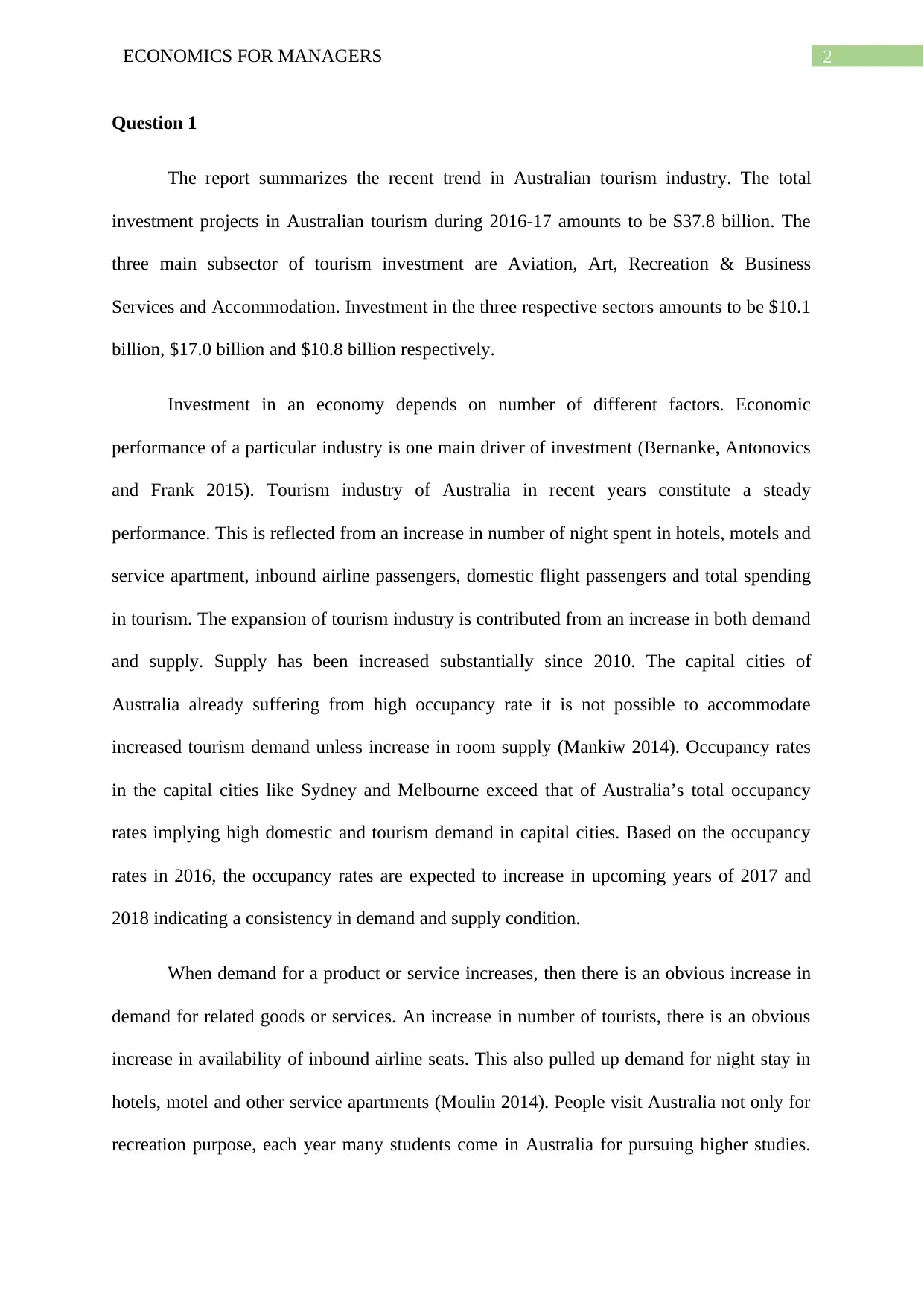
2ECONOMICS FOR MANAGERS
Question 1
The report summarizes the recent trend in Australian tourism industry. The total
investment projects in Australian tourism during 2016-17 amounts to be $37.8 billion. The
three main subsector of tourism investment are Aviation, Art, Recreation & Business
Services and Accommodation. Investment in the three respective sectors amounts to be $10.1
billion, $17.0 billion and $10.8 billion respectively.
Investment in an economy depends on number of different factors. Economic
performance of a particular industry is one main driver of investment (Bernanke, Antonovics
and Frank 2015). Tourism industry of Australia in recent years constitute a steady
performance. This is reflected from an increase in number of night spent in hotels, motels and
service apartment, inbound airline passengers, domestic flight passengers and total spending
in tourism. The expansion of tourism industry is contributed from an increase in both demand
and supply. Supply has been increased substantially since 2010. The capital cities of
Australia already suffering from high occupancy rate it is not possible to accommodate
increased tourism demand unless increase in room supply (Mankiw 2014). Occupancy rates
in the capital cities like Sydney and Melbourne exceed that of Australia’s total occupancy
rates implying high domestic and tourism demand in capital cities. Based on the occupancy
rates in 2016, the occupancy rates are expected to increase in upcoming years of 2017 and
2018 indicating a consistency in demand and supply condition.
When demand for a product or service increases, then there is an obvious increase in
demand for related goods or services. An increase in number of tourists, there is an obvious
increase in availability of inbound airline seats. This also pulled up demand for night stay in
hotels, motel and other service apartments (Moulin 2014). People visit Australia not only for
recreation purpose, each year many students come in Australia for pursuing higher studies.
Question 1
The report summarizes the recent trend in Australian tourism industry. The total
investment projects in Australian tourism during 2016-17 amounts to be $37.8 billion. The
three main subsector of tourism investment are Aviation, Art, Recreation & Business
Services and Accommodation. Investment in the three respective sectors amounts to be $10.1
billion, $17.0 billion and $10.8 billion respectively.
Investment in an economy depends on number of different factors. Economic
performance of a particular industry is one main driver of investment (Bernanke, Antonovics
and Frank 2015). Tourism industry of Australia in recent years constitute a steady
performance. This is reflected from an increase in number of night spent in hotels, motels and
service apartment, inbound airline passengers, domestic flight passengers and total spending
in tourism. The expansion of tourism industry is contributed from an increase in both demand
and supply. Supply has been increased substantially since 2010. The capital cities of
Australia already suffering from high occupancy rate it is not possible to accommodate
increased tourism demand unless increase in room supply (Mankiw 2014). Occupancy rates
in the capital cities like Sydney and Melbourne exceed that of Australia’s total occupancy
rates implying high domestic and tourism demand in capital cities. Based on the occupancy
rates in 2016, the occupancy rates are expected to increase in upcoming years of 2017 and
2018 indicating a consistency in demand and supply condition.
When demand for a product or service increases, then there is an obvious increase in
demand for related goods or services. An increase in number of tourists, there is an obvious
increase in availability of inbound airline seats. This also pulled up demand for night stay in
hotels, motel and other service apartments (Moulin 2014). People visit Australia not only for
recreation purpose, each year many students come in Australia for pursuing higher studies.
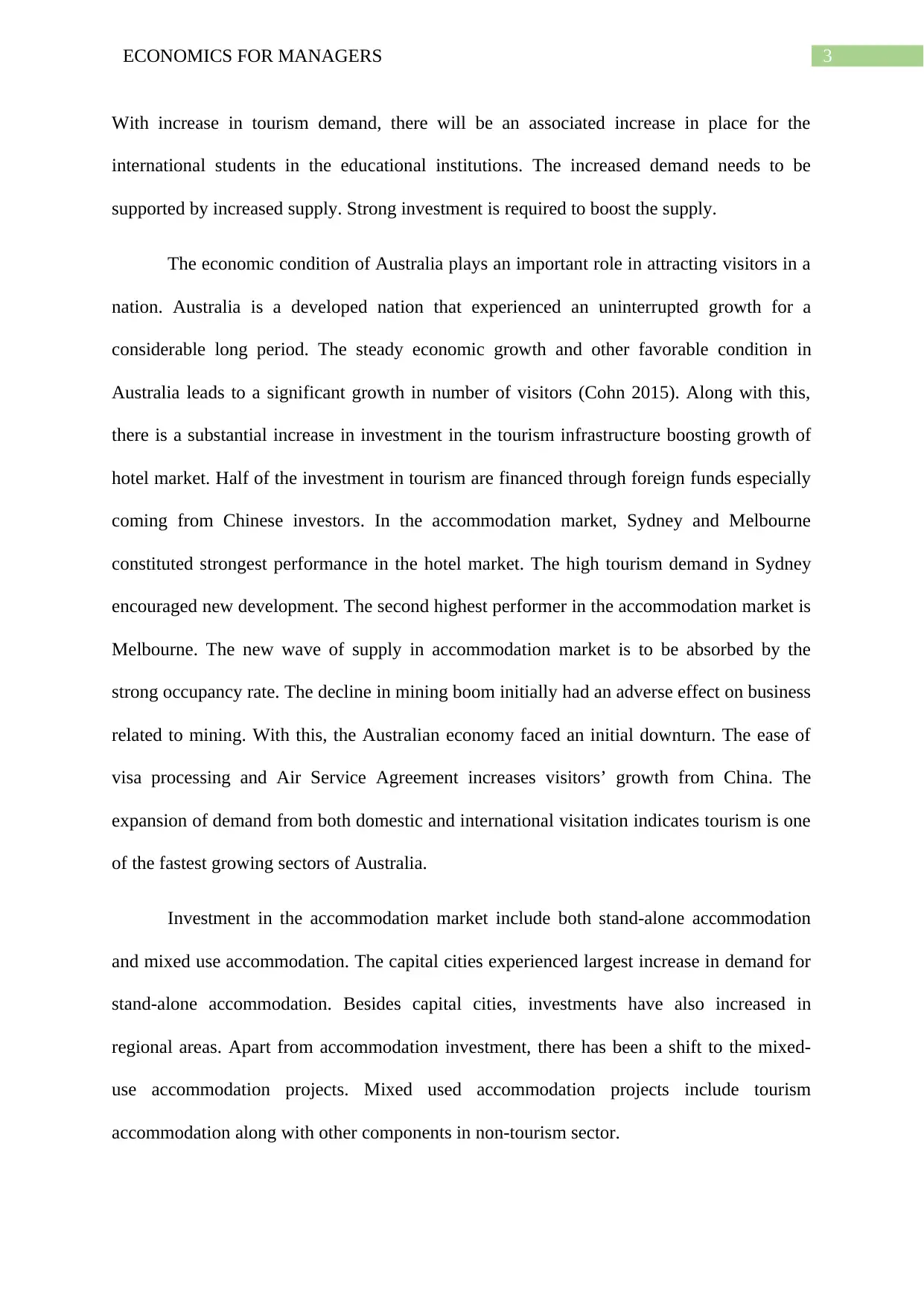
3ECONOMICS FOR MANAGERS
With increase in tourism demand, there will be an associated increase in place for the
international students in the educational institutions. The increased demand needs to be
supported by increased supply. Strong investment is required to boost the supply.
The economic condition of Australia plays an important role in attracting visitors in a
nation. Australia is a developed nation that experienced an uninterrupted growth for a
considerable long period. The steady economic growth and other favorable condition in
Australia leads to a significant growth in number of visitors (Cohn 2015). Along with this,
there is a substantial increase in investment in the tourism infrastructure boosting growth of
hotel market. Half of the investment in tourism are financed through foreign funds especially
coming from Chinese investors. In the accommodation market, Sydney and Melbourne
constituted strongest performance in the hotel market. The high tourism demand in Sydney
encouraged new development. The second highest performer in the accommodation market is
Melbourne. The new wave of supply in accommodation market is to be absorbed by the
strong occupancy rate. The decline in mining boom initially had an adverse effect on business
related to mining. With this, the Australian economy faced an initial downturn. The ease of
visa processing and Air Service Agreement increases visitors’ growth from China. The
expansion of demand from both domestic and international visitation indicates tourism is one
of the fastest growing sectors of Australia.
Investment in the accommodation market include both stand-alone accommodation
and mixed use accommodation. The capital cities experienced largest increase in demand for
stand-alone accommodation. Besides capital cities, investments have also increased in
regional areas. Apart from accommodation investment, there has been a shift to the mixed-
use accommodation projects. Mixed used accommodation projects include tourism
accommodation along with other components in non-tourism sector.
With increase in tourism demand, there will be an associated increase in place for the
international students in the educational institutions. The increased demand needs to be
supported by increased supply. Strong investment is required to boost the supply.
The economic condition of Australia plays an important role in attracting visitors in a
nation. Australia is a developed nation that experienced an uninterrupted growth for a
considerable long period. The steady economic growth and other favorable condition in
Australia leads to a significant growth in number of visitors (Cohn 2015). Along with this,
there is a substantial increase in investment in the tourism infrastructure boosting growth of
hotel market. Half of the investment in tourism are financed through foreign funds especially
coming from Chinese investors. In the accommodation market, Sydney and Melbourne
constituted strongest performance in the hotel market. The high tourism demand in Sydney
encouraged new development. The second highest performer in the accommodation market is
Melbourne. The new wave of supply in accommodation market is to be absorbed by the
strong occupancy rate. The decline in mining boom initially had an adverse effect on business
related to mining. With this, the Australian economy faced an initial downturn. The ease of
visa processing and Air Service Agreement increases visitors’ growth from China. The
expansion of demand from both domestic and international visitation indicates tourism is one
of the fastest growing sectors of Australia.
Investment in the accommodation market include both stand-alone accommodation
and mixed use accommodation. The capital cities experienced largest increase in demand for
stand-alone accommodation. Besides capital cities, investments have also increased in
regional areas. Apart from accommodation investment, there has been a shift to the mixed-
use accommodation projects. Mixed used accommodation projects include tourism
accommodation along with other components in non-tourism sector.
Secure Best Marks with AI Grader
Need help grading? Try our AI Grader for instant feedback on your assignments.
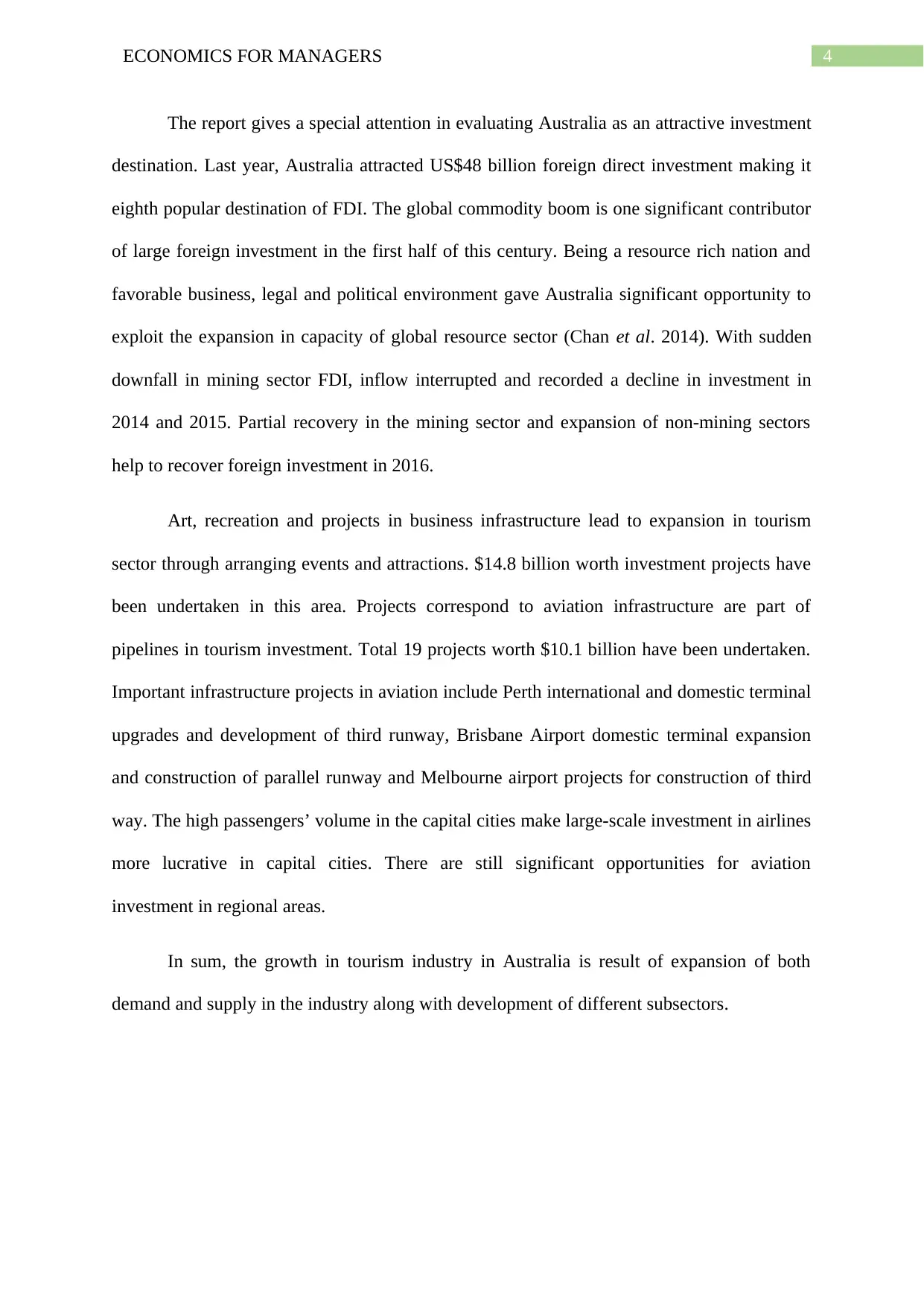
4ECONOMICS FOR MANAGERS
The report gives a special attention in evaluating Australia as an attractive investment
destination. Last year, Australia attracted US$48 billion foreign direct investment making it
eighth popular destination of FDI. The global commodity boom is one significant contributor
of large foreign investment in the first half of this century. Being a resource rich nation and
favorable business, legal and political environment gave Australia significant opportunity to
exploit the expansion in capacity of global resource sector (Chan et al. 2014). With sudden
downfall in mining sector FDI, inflow interrupted and recorded a decline in investment in
2014 and 2015. Partial recovery in the mining sector and expansion of non-mining sectors
help to recover foreign investment in 2016.
Art, recreation and projects in business infrastructure lead to expansion in tourism
sector through arranging events and attractions. $14.8 billion worth investment projects have
been undertaken in this area. Projects correspond to aviation infrastructure are part of
pipelines in tourism investment. Total 19 projects worth $10.1 billion have been undertaken.
Important infrastructure projects in aviation include Perth international and domestic terminal
upgrades and development of third runway, Brisbane Airport domestic terminal expansion
and construction of parallel runway and Melbourne airport projects for construction of third
way. The high passengers’ volume in the capital cities make large-scale investment in airlines
more lucrative in capital cities. There are still significant opportunities for aviation
investment in regional areas.
In sum, the growth in tourism industry in Australia is result of expansion of both
demand and supply in the industry along with development of different subsectors.
The report gives a special attention in evaluating Australia as an attractive investment
destination. Last year, Australia attracted US$48 billion foreign direct investment making it
eighth popular destination of FDI. The global commodity boom is one significant contributor
of large foreign investment in the first half of this century. Being a resource rich nation and
favorable business, legal and political environment gave Australia significant opportunity to
exploit the expansion in capacity of global resource sector (Chan et al. 2014). With sudden
downfall in mining sector FDI, inflow interrupted and recorded a decline in investment in
2014 and 2015. Partial recovery in the mining sector and expansion of non-mining sectors
help to recover foreign investment in 2016.
Art, recreation and projects in business infrastructure lead to expansion in tourism
sector through arranging events and attractions. $14.8 billion worth investment projects have
been undertaken in this area. Projects correspond to aviation infrastructure are part of
pipelines in tourism investment. Total 19 projects worth $10.1 billion have been undertaken.
Important infrastructure projects in aviation include Perth international and domestic terminal
upgrades and development of third runway, Brisbane Airport domestic terminal expansion
and construction of parallel runway and Melbourne airport projects for construction of third
way. The high passengers’ volume in the capital cities make large-scale investment in airlines
more lucrative in capital cities. There are still significant opportunities for aviation
investment in regional areas.
In sum, the growth in tourism industry in Australia is result of expansion of both
demand and supply in the industry along with development of different subsectors.

5ECONOMICS FOR MANAGERS
Question 2
Question a
Figure 1: Effect of a specific tax on buyers in hotel accommodation market
Given the perfectly competitive market of hotel accommodation, the demand and
supply for hotel accommodations are given as DD and SS respectively. In the competitive
market equilibrium is determined from intersection of demand and supply curve (Hill and
Schiller 2015). The equilibrium price and quantity of hotel accommodation before
implementation of tax is given as P* and Q* respectively. The consumer surplus under free
market equilibrium is equivalent to the area A+B+C+D. The surplus to producers are given
by the area E+F+G+H. The total surplus is then given as A+B+C+D+E+F+G+H. When
government decides to levy a tax on buyers of hotel accommodation, buyers are discouraged
to use hotel accommodation. This reduces demand for hotel accommodation shifting the
demand curve of hotel accommodation to the left. The new demand curve for hotel
accommodation is D1D1. Price paid by buyers’ increase to P1 while sellers’ receive a lower
price of P2. The higher price reduces consumers’ surplus to area A only. The surplus to
Question 2
Question a
Figure 1: Effect of a specific tax on buyers in hotel accommodation market
Given the perfectly competitive market of hotel accommodation, the demand and
supply for hotel accommodations are given as DD and SS respectively. In the competitive
market equilibrium is determined from intersection of demand and supply curve (Hill and
Schiller 2015). The equilibrium price and quantity of hotel accommodation before
implementation of tax is given as P* and Q* respectively. The consumer surplus under free
market equilibrium is equivalent to the area A+B+C+D. The surplus to producers are given
by the area E+F+G+H. The total surplus is then given as A+B+C+D+E+F+G+H. When
government decides to levy a tax on buyers of hotel accommodation, buyers are discouraged
to use hotel accommodation. This reduces demand for hotel accommodation shifting the
demand curve of hotel accommodation to the left. The new demand curve for hotel
accommodation is D1D1. Price paid by buyers’ increase to P1 while sellers’ receive a lower
price of P2. The higher price reduces consumers’ surplus to area A only. The surplus to
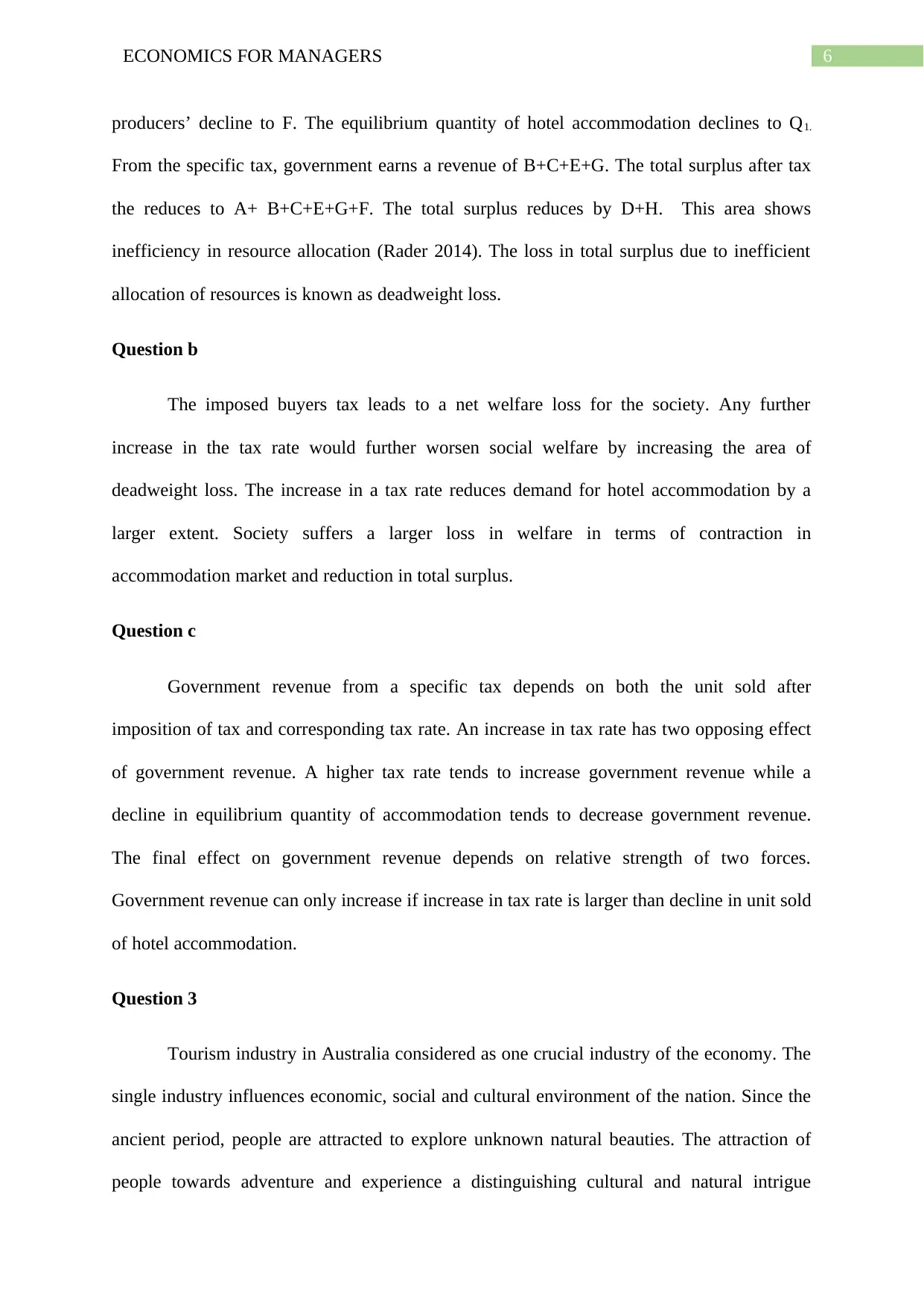
6ECONOMICS FOR MANAGERS
producers’ decline to F. The equilibrium quantity of hotel accommodation declines to Q1.
From the specific tax, government earns a revenue of B+C+E+G. The total surplus after tax
the reduces to A+ B+C+E+G+F. The total surplus reduces by D+H. This area shows
inefficiency in resource allocation (Rader 2014). The loss in total surplus due to inefficient
allocation of resources is known as deadweight loss.
Question b
The imposed buyers tax leads to a net welfare loss for the society. Any further
increase in the tax rate would further worsen social welfare by increasing the area of
deadweight loss. The increase in a tax rate reduces demand for hotel accommodation by a
larger extent. Society suffers a larger loss in welfare in terms of contraction in
accommodation market and reduction in total surplus.
Question c
Government revenue from a specific tax depends on both the unit sold after
imposition of tax and corresponding tax rate. An increase in tax rate has two opposing effect
of government revenue. A higher tax rate tends to increase government revenue while a
decline in equilibrium quantity of accommodation tends to decrease government revenue.
The final effect on government revenue depends on relative strength of two forces.
Government revenue can only increase if increase in tax rate is larger than decline in unit sold
of hotel accommodation.
Question 3
Tourism industry in Australia considered as one crucial industry of the economy. The
single industry influences economic, social and cultural environment of the nation. Since the
ancient period, people are attracted to explore unknown natural beauties. The attraction of
people towards adventure and experience a distinguishing cultural and natural intrigue
producers’ decline to F. The equilibrium quantity of hotel accommodation declines to Q1.
From the specific tax, government earns a revenue of B+C+E+G. The total surplus after tax
the reduces to A+ B+C+E+G+F. The total surplus reduces by D+H. This area shows
inefficiency in resource allocation (Rader 2014). The loss in total surplus due to inefficient
allocation of resources is known as deadweight loss.
Question b
The imposed buyers tax leads to a net welfare loss for the society. Any further
increase in the tax rate would further worsen social welfare by increasing the area of
deadweight loss. The increase in a tax rate reduces demand for hotel accommodation by a
larger extent. Society suffers a larger loss in welfare in terms of contraction in
accommodation market and reduction in total surplus.
Question c
Government revenue from a specific tax depends on both the unit sold after
imposition of tax and corresponding tax rate. An increase in tax rate has two opposing effect
of government revenue. A higher tax rate tends to increase government revenue while a
decline in equilibrium quantity of accommodation tends to decrease government revenue.
The final effect on government revenue depends on relative strength of two forces.
Government revenue can only increase if increase in tax rate is larger than decline in unit sold
of hotel accommodation.
Question 3
Tourism industry in Australia considered as one crucial industry of the economy. The
single industry influences economic, social and cultural environment of the nation. Since the
ancient period, people are attracted to explore unknown natural beauties. The attraction of
people towards adventure and experience a distinguishing cultural and natural intrigue
Paraphrase This Document
Need a fresh take? Get an instant paraphrase of this document with our AI Paraphraser

7ECONOMICS FOR MANAGERS
prepares the basis for tourism industry (Austrade.gov.au. 2018) Tourism contributes to the
Australian economy in terms of its influence on national income, government revenue, export
earning, employment and capital investment. The contribution of tourism industry is
evaluated in terms of both direct and indirect contribution in the economy. One direct
contribution of the industry to the Australian economy is to boost the national income. The
investment in tourism industry boosts investment in other related sectors such as
accommodation, airlines, art, recreation and other business projects. A significant share of
GDP is contributed from the tourism industry. The share of the industry in national income
reflects the importance of the industry for internal and government spending (Basu 2017).
Tourism not only contributes to investment at present but also a significant investment is
made on future activity through this industry.
In total Australian’s GDP, hare of tourism industry was 3.0 percent in 2016. In
monetary terms, the industry added nearly 49.7bn. Observing growth of the tourism industry,
analysts forecast to increase the share of tourism in Australia’s GDP to be increased to 4.0
percent in the next year (Randle and Hoye 2016). Apart from direct contribution of tourism to
national income indirect contribution to the national income derived from its contribution in
expansion of associated industries such as accommodation market, transportation, travel
agency, leisure, restaurant and other business.
Expansion of tourism industry results in a greater utilization of existing plant and
capital equipment such as building, coaches and aircrafts. The tourism industry in Australia
brings a large volume of capital investment. The investment in tourism amounts
approximately AUD 21.7 bn. Tourism also makes a significant contribution in the balance of
payment account of Australia. Australia enjoys a comparative advantage in tourism due to
appealing scenic beauty, proximity to Asia, safe environment and benefits from cheaper
airlines (Pc.gov.au. 2018) The visitors’ export makes significant contribution to the
prepares the basis for tourism industry (Austrade.gov.au. 2018) Tourism contributes to the
Australian economy in terms of its influence on national income, government revenue, export
earning, employment and capital investment. The contribution of tourism industry is
evaluated in terms of both direct and indirect contribution in the economy. One direct
contribution of the industry to the Australian economy is to boost the national income. The
investment in tourism industry boosts investment in other related sectors such as
accommodation, airlines, art, recreation and other business projects. A significant share of
GDP is contributed from the tourism industry. The share of the industry in national income
reflects the importance of the industry for internal and government spending (Basu 2017).
Tourism not only contributes to investment at present but also a significant investment is
made on future activity through this industry.
In total Australian’s GDP, hare of tourism industry was 3.0 percent in 2016. In
monetary terms, the industry added nearly 49.7bn. Observing growth of the tourism industry,
analysts forecast to increase the share of tourism in Australia’s GDP to be increased to 4.0
percent in the next year (Randle and Hoye 2016). Apart from direct contribution of tourism to
national income indirect contribution to the national income derived from its contribution in
expansion of associated industries such as accommodation market, transportation, travel
agency, leisure, restaurant and other business.
Expansion of tourism industry results in a greater utilization of existing plant and
capital equipment such as building, coaches and aircrafts. The tourism industry in Australia
brings a large volume of capital investment. The investment in tourism amounts
approximately AUD 21.7 bn. Tourism also makes a significant contribution in the balance of
payment account of Australia. Australia enjoys a comparative advantage in tourism due to
appealing scenic beauty, proximity to Asia, safe environment and benefits from cheaper
airlines (Pc.gov.au. 2018) The visitors’ export makes significant contribution to the
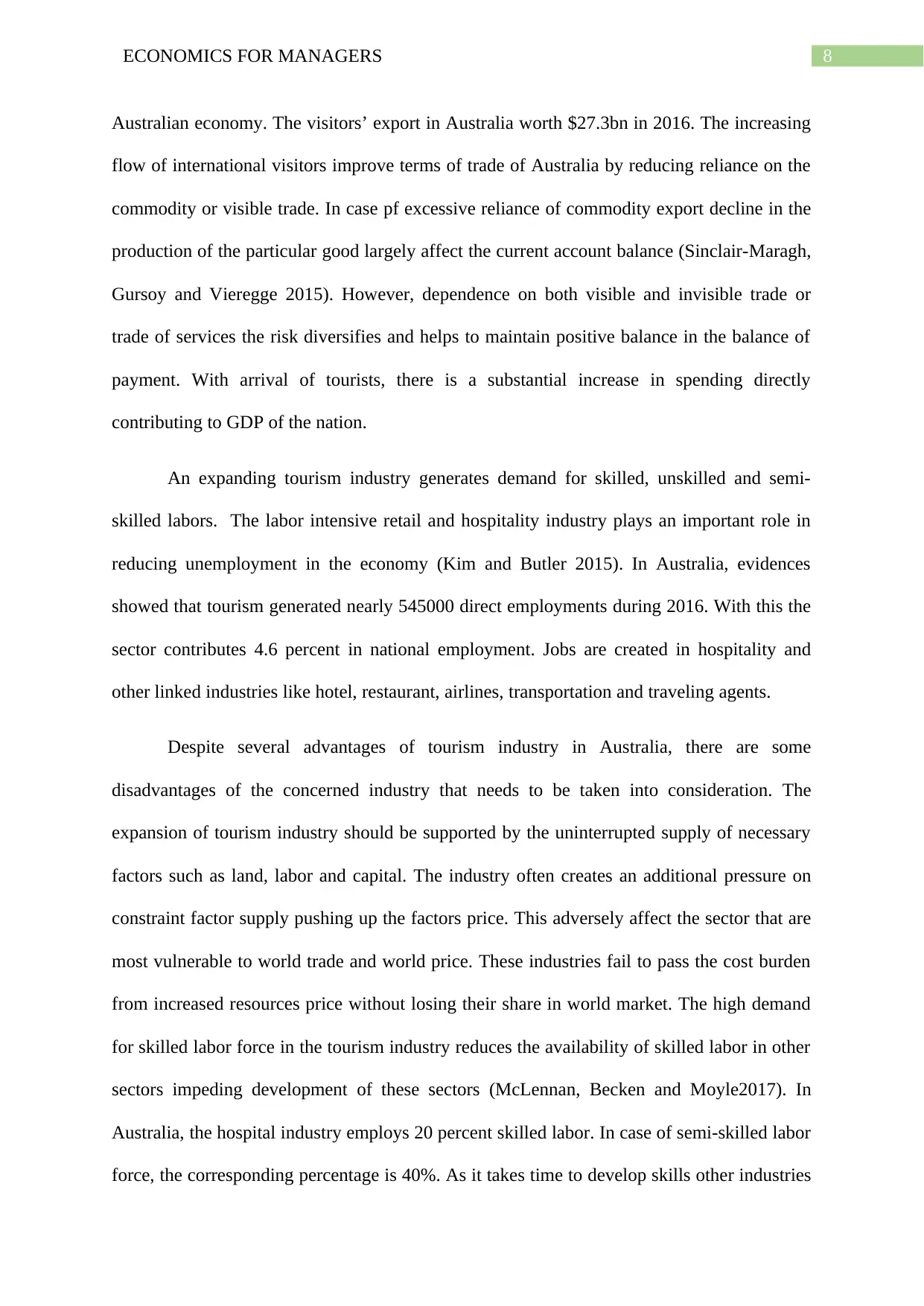
8ECONOMICS FOR MANAGERS
Australian economy. The visitors’ export in Australia worth $27.3bn in 2016. The increasing
flow of international visitors improve terms of trade of Australia by reducing reliance on the
commodity or visible trade. In case pf excessive reliance of commodity export decline in the
production of the particular good largely affect the current account balance (Sinclair-Maragh,
Gursoy and Vieregge 2015). However, dependence on both visible and invisible trade or
trade of services the risk diversifies and helps to maintain positive balance in the balance of
payment. With arrival of tourists, there is a substantial increase in spending directly
contributing to GDP of the nation.
An expanding tourism industry generates demand for skilled, unskilled and semi-
skilled labors. The labor intensive retail and hospitality industry plays an important role in
reducing unemployment in the economy (Kim and Butler 2015). In Australia, evidences
showed that tourism generated nearly 545000 direct employments during 2016. With this the
sector contributes 4.6 percent in national employment. Jobs are created in hospitality and
other linked industries like hotel, restaurant, airlines, transportation and traveling agents.
Despite several advantages of tourism industry in Australia, there are some
disadvantages of the concerned industry that needs to be taken into consideration. The
expansion of tourism industry should be supported by the uninterrupted supply of necessary
factors such as land, labor and capital. The industry often creates an additional pressure on
constraint factor supply pushing up the factors price. This adversely affect the sector that are
most vulnerable to world trade and world price. These industries fail to pass the cost burden
from increased resources price without losing their share in world market. The high demand
for skilled labor force in the tourism industry reduces the availability of skilled labor in other
sectors impeding development of these sectors (McLennan, Becken and Moyle2017). In
Australia, the hospital industry employs 20 percent skilled labor. In case of semi-skilled labor
force, the corresponding percentage is 40%. As it takes time to develop skills other industries
Australian economy. The visitors’ export in Australia worth $27.3bn in 2016. The increasing
flow of international visitors improve terms of trade of Australia by reducing reliance on the
commodity or visible trade. In case pf excessive reliance of commodity export decline in the
production of the particular good largely affect the current account balance (Sinclair-Maragh,
Gursoy and Vieregge 2015). However, dependence on both visible and invisible trade or
trade of services the risk diversifies and helps to maintain positive balance in the balance of
payment. With arrival of tourists, there is a substantial increase in spending directly
contributing to GDP of the nation.
An expanding tourism industry generates demand for skilled, unskilled and semi-
skilled labors. The labor intensive retail and hospitality industry plays an important role in
reducing unemployment in the economy (Kim and Butler 2015). In Australia, evidences
showed that tourism generated nearly 545000 direct employments during 2016. With this the
sector contributes 4.6 percent in national employment. Jobs are created in hospitality and
other linked industries like hotel, restaurant, airlines, transportation and traveling agents.
Despite several advantages of tourism industry in Australia, there are some
disadvantages of the concerned industry that needs to be taken into consideration. The
expansion of tourism industry should be supported by the uninterrupted supply of necessary
factors such as land, labor and capital. The industry often creates an additional pressure on
constraint factor supply pushing up the factors price. This adversely affect the sector that are
most vulnerable to world trade and world price. These industries fail to pass the cost burden
from increased resources price without losing their share in world market. The high demand
for skilled labor force in the tourism industry reduces the availability of skilled labor in other
sectors impeding development of these sectors (McLennan, Becken and Moyle2017). In
Australia, the hospital industry employs 20 percent skilled labor. In case of semi-skilled labor
force, the corresponding percentage is 40%. As it takes time to develop skills other industries
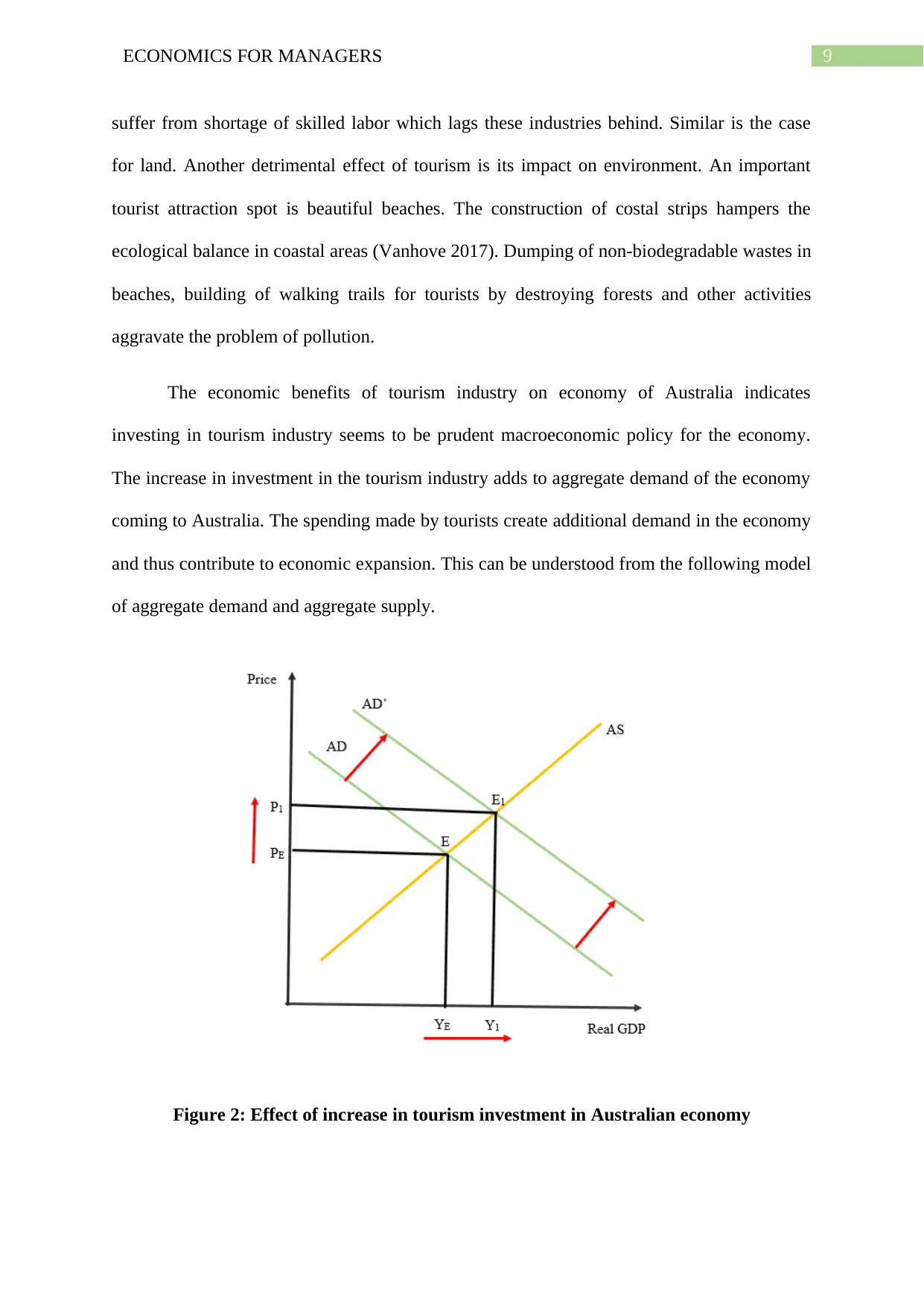
9ECONOMICS FOR MANAGERS
suffer from shortage of skilled labor which lags these industries behind. Similar is the case
for land. Another detrimental effect of tourism is its impact on environment. An important
tourist attraction spot is beautiful beaches. The construction of costal strips hampers the
ecological balance in coastal areas (Vanhove 2017). Dumping of non-biodegradable wastes in
beaches, building of walking trails for tourists by destroying forests and other activities
aggravate the problem of pollution.
The economic benefits of tourism industry on economy of Australia indicates
investing in tourism industry seems to be prudent macroeconomic policy for the economy.
The increase in investment in the tourism industry adds to aggregate demand of the economy
coming to Australia. The spending made by tourists create additional demand in the economy
and thus contribute to economic expansion. This can be understood from the following model
of aggregate demand and aggregate supply.
Figure 2: Effect of increase in tourism investment in Australian economy
suffer from shortage of skilled labor which lags these industries behind. Similar is the case
for land. Another detrimental effect of tourism is its impact on environment. An important
tourist attraction spot is beautiful beaches. The construction of costal strips hampers the
ecological balance in coastal areas (Vanhove 2017). Dumping of non-biodegradable wastes in
beaches, building of walking trails for tourists by destroying forests and other activities
aggravate the problem of pollution.
The economic benefits of tourism industry on economy of Australia indicates
investing in tourism industry seems to be prudent macroeconomic policy for the economy.
The increase in investment in the tourism industry adds to aggregate demand of the economy
coming to Australia. The spending made by tourists create additional demand in the economy
and thus contribute to economic expansion. This can be understood from the following model
of aggregate demand and aggregate supply.
Figure 2: Effect of increase in tourism investment in Australian economy
Secure Best Marks with AI Grader
Need help grading? Try our AI Grader for instant feedback on your assignments.
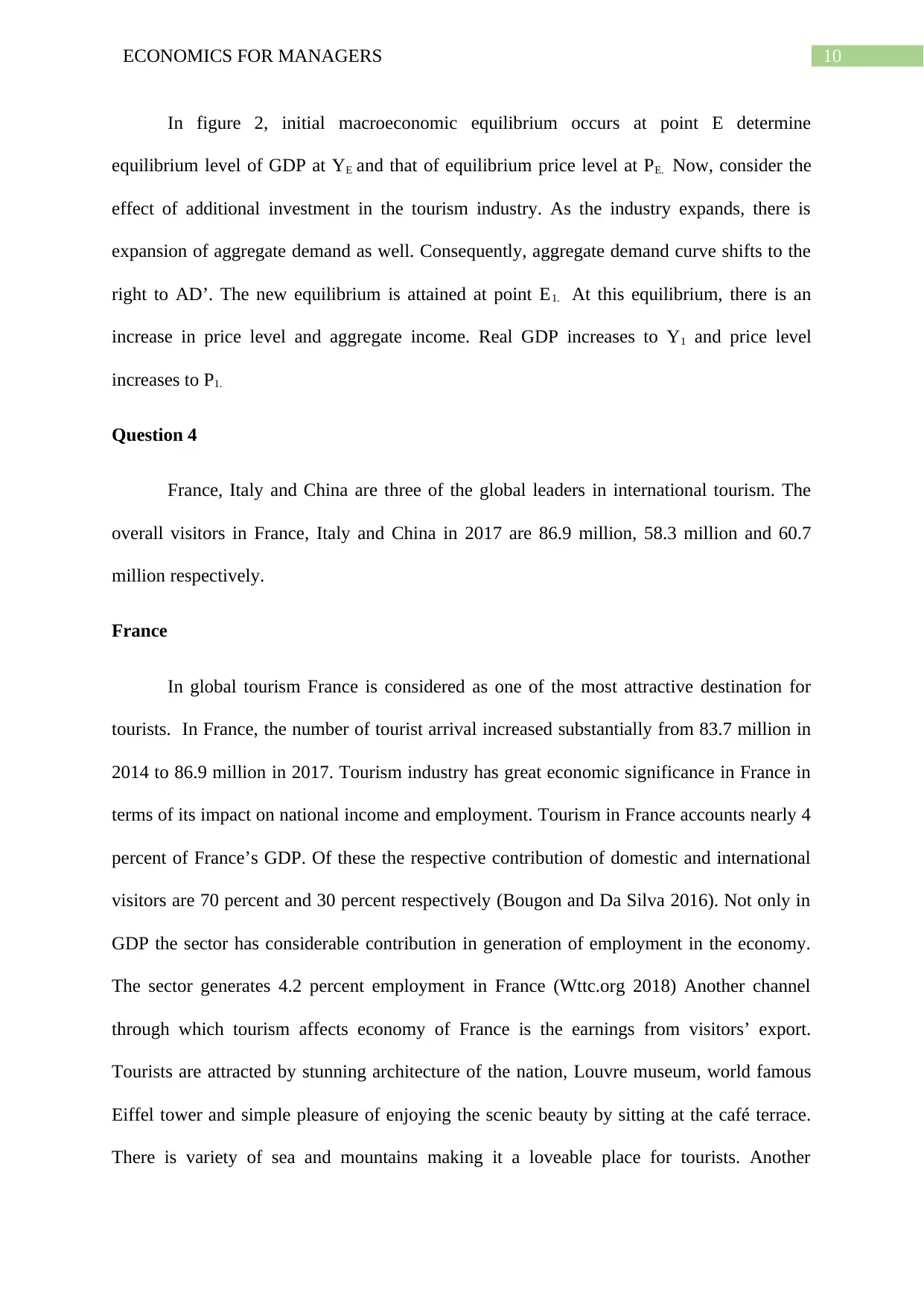
10ECONOMICS FOR MANAGERS
In figure 2, initial macroeconomic equilibrium occurs at point E determine
equilibrium level of GDP at YE and that of equilibrium price level at PE. Now, consider the
effect of additional investment in the tourism industry. As the industry expands, there is
expansion of aggregate demand as well. Consequently, aggregate demand curve shifts to the
right to AD’. The new equilibrium is attained at point E1. At this equilibrium, there is an
increase in price level and aggregate income. Real GDP increases to Y1 and price level
increases to P1.
Question 4
France, Italy and China are three of the global leaders in international tourism. The
overall visitors in France, Italy and China in 2017 are 86.9 million, 58.3 million and 60.7
million respectively.
France
In global tourism France is considered as one of the most attractive destination for
tourists. In France, the number of tourist arrival increased substantially from 83.7 million in
2014 to 86.9 million in 2017. Tourism industry has great economic significance in France in
terms of its impact on national income and employment. Tourism in France accounts nearly 4
percent of France’s GDP. Of these the respective contribution of domestic and international
visitors are 70 percent and 30 percent respectively (Bougon and Da Silva 2016). Not only in
GDP the sector has considerable contribution in generation of employment in the economy.
The sector generates 4.2 percent employment in France (Wttc.org 2018) Another channel
through which tourism affects economy of France is the earnings from visitors’ export.
Tourists are attracted by stunning architecture of the nation, Louvre museum, world famous
Eiffel tower and simple pleasure of enjoying the scenic beauty by sitting at the café terrace.
There is variety of sea and mountains making it a loveable place for tourists. Another
In figure 2, initial macroeconomic equilibrium occurs at point E determine
equilibrium level of GDP at YE and that of equilibrium price level at PE. Now, consider the
effect of additional investment in the tourism industry. As the industry expands, there is
expansion of aggregate demand as well. Consequently, aggregate demand curve shifts to the
right to AD’. The new equilibrium is attained at point E1. At this equilibrium, there is an
increase in price level and aggregate income. Real GDP increases to Y1 and price level
increases to P1.
Question 4
France, Italy and China are three of the global leaders in international tourism. The
overall visitors in France, Italy and China in 2017 are 86.9 million, 58.3 million and 60.7
million respectively.
France
In global tourism France is considered as one of the most attractive destination for
tourists. In France, the number of tourist arrival increased substantially from 83.7 million in
2014 to 86.9 million in 2017. Tourism industry has great economic significance in France in
terms of its impact on national income and employment. Tourism in France accounts nearly 4
percent of France’s GDP. Of these the respective contribution of domestic and international
visitors are 70 percent and 30 percent respectively (Bougon and Da Silva 2016). Not only in
GDP the sector has considerable contribution in generation of employment in the economy.
The sector generates 4.2 percent employment in France (Wttc.org 2018) Another channel
through which tourism affects economy of France is the earnings from visitors’ export.
Tourists are attracted by stunning architecture of the nation, Louvre museum, world famous
Eiffel tower and simple pleasure of enjoying the scenic beauty by sitting at the café terrace.
There is variety of sea and mountains making it a loveable place for tourists. Another
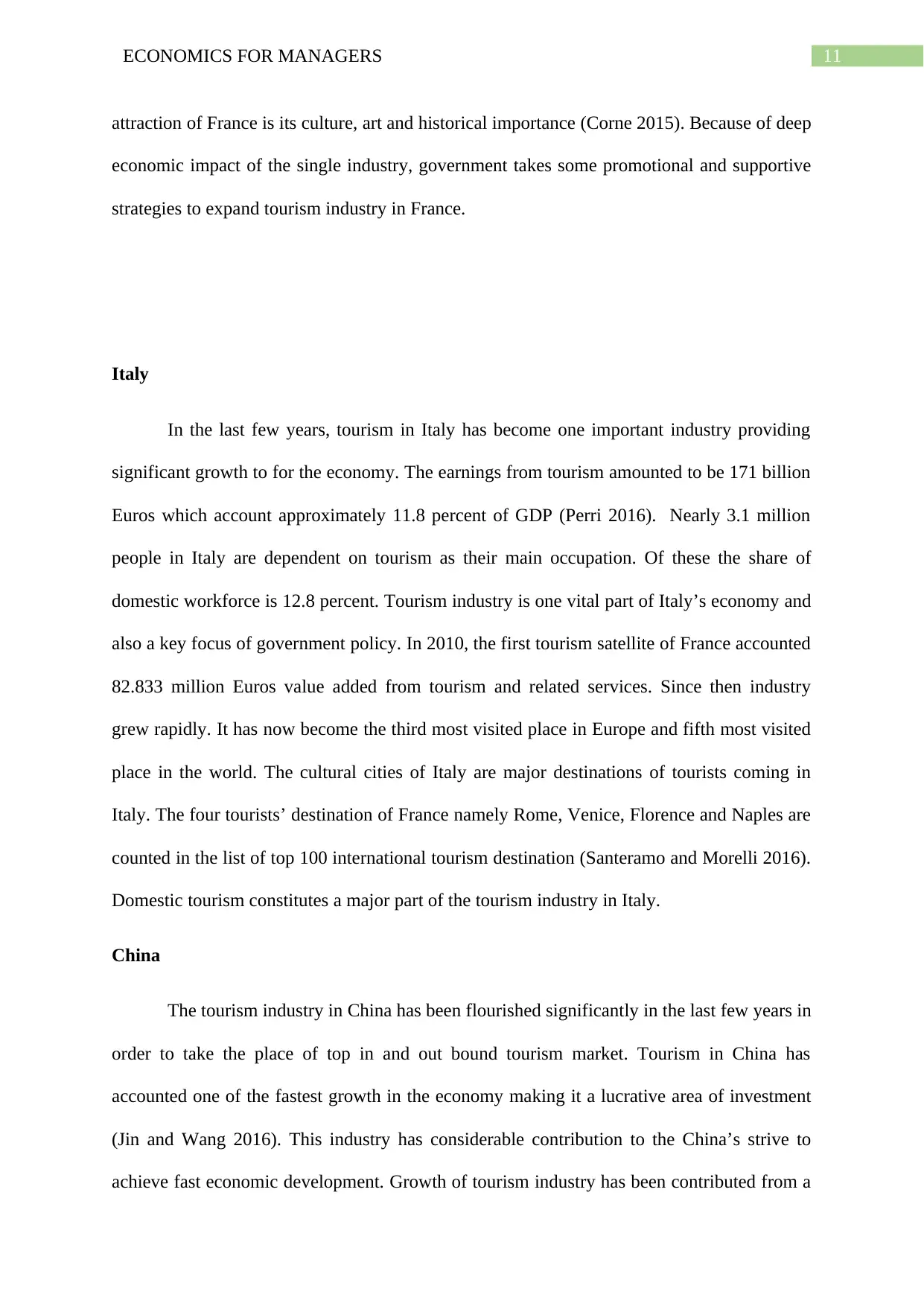
11ECONOMICS FOR MANAGERS
attraction of France is its culture, art and historical importance (Corne 2015). Because of deep
economic impact of the single industry, government takes some promotional and supportive
strategies to expand tourism industry in France.
Italy
In the last few years, tourism in Italy has become one important industry providing
significant growth to for the economy. The earnings from tourism amounted to be 171 billion
Euros which account approximately 11.8 percent of GDP (Perri 2016). Nearly 3.1 million
people in Italy are dependent on tourism as their main occupation. Of these the share of
domestic workforce is 12.8 percent. Tourism industry is one vital part of Italy’s economy and
also a key focus of government policy. In 2010, the first tourism satellite of France accounted
82.833 million Euros value added from tourism and related services. Since then industry
grew rapidly. It has now become the third most visited place in Europe and fifth most visited
place in the world. The cultural cities of Italy are major destinations of tourists coming in
Italy. The four tourists’ destination of France namely Rome, Venice, Florence and Naples are
counted in the list of top 100 international tourism destination (Santeramo and Morelli 2016).
Domestic tourism constitutes a major part of the tourism industry in Italy.
China
The tourism industry in China has been flourished significantly in the last few years in
order to take the place of top in and out bound tourism market. Tourism in China has
accounted one of the fastest growth in the economy making it a lucrative area of investment
(Jin and Wang 2016). This industry has considerable contribution to the China’s strive to
achieve fast economic development. Growth of tourism industry has been contributed from a
attraction of France is its culture, art and historical importance (Corne 2015). Because of deep
economic impact of the single industry, government takes some promotional and supportive
strategies to expand tourism industry in France.
Italy
In the last few years, tourism in Italy has become one important industry providing
significant growth to for the economy. The earnings from tourism amounted to be 171 billion
Euros which account approximately 11.8 percent of GDP (Perri 2016). Nearly 3.1 million
people in Italy are dependent on tourism as their main occupation. Of these the share of
domestic workforce is 12.8 percent. Tourism industry is one vital part of Italy’s economy and
also a key focus of government policy. In 2010, the first tourism satellite of France accounted
82.833 million Euros value added from tourism and related services. Since then industry
grew rapidly. It has now become the third most visited place in Europe and fifth most visited
place in the world. The cultural cities of Italy are major destinations of tourists coming in
Italy. The four tourists’ destination of France namely Rome, Venice, Florence and Naples are
counted in the list of top 100 international tourism destination (Santeramo and Morelli 2016).
Domestic tourism constitutes a major part of the tourism industry in Italy.
China
The tourism industry in China has been flourished significantly in the last few years in
order to take the place of top in and out bound tourism market. Tourism in China has
accounted one of the fastest growth in the economy making it a lucrative area of investment
(Jin and Wang 2016). This industry has considerable contribution to the China’s strive to
achieve fast economic development. Growth of tourism industry has been contributed from a
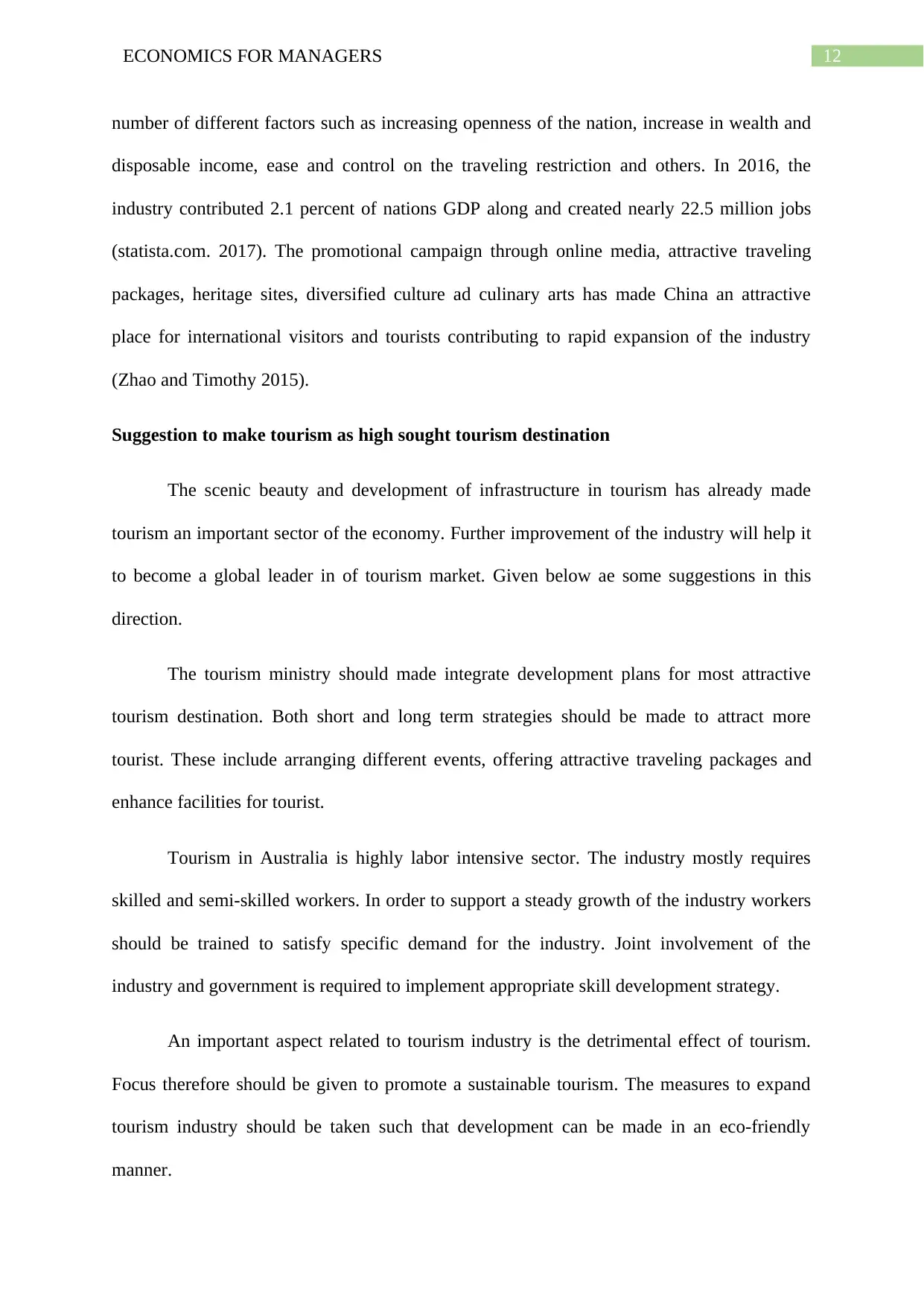
12ECONOMICS FOR MANAGERS
number of different factors such as increasing openness of the nation, increase in wealth and
disposable income, ease and control on the traveling restriction and others. In 2016, the
industry contributed 2.1 percent of nations GDP along and created nearly 22.5 million jobs
(statista.com. 2017). The promotional campaign through online media, attractive traveling
packages, heritage sites, diversified culture ad culinary arts has made China an attractive
place for international visitors and tourists contributing to rapid expansion of the industry
(Zhao and Timothy 2015).
Suggestion to make tourism as high sought tourism destination
The scenic beauty and development of infrastructure in tourism has already made
tourism an important sector of the economy. Further improvement of the industry will help it
to become a global leader in of tourism market. Given below ae some suggestions in this
direction.
The tourism ministry should made integrate development plans for most attractive
tourism destination. Both short and long term strategies should be made to attract more
tourist. These include arranging different events, offering attractive traveling packages and
enhance facilities for tourist.
Tourism in Australia is highly labor intensive sector. The industry mostly requires
skilled and semi-skilled workers. In order to support a steady growth of the industry workers
should be trained to satisfy specific demand for the industry. Joint involvement of the
industry and government is required to implement appropriate skill development strategy.
An important aspect related to tourism industry is the detrimental effect of tourism.
Focus therefore should be given to promote a sustainable tourism. The measures to expand
tourism industry should be taken such that development can be made in an eco-friendly
manner.
number of different factors such as increasing openness of the nation, increase in wealth and
disposable income, ease and control on the traveling restriction and others. In 2016, the
industry contributed 2.1 percent of nations GDP along and created nearly 22.5 million jobs
(statista.com. 2017). The promotional campaign through online media, attractive traveling
packages, heritage sites, diversified culture ad culinary arts has made China an attractive
place for international visitors and tourists contributing to rapid expansion of the industry
(Zhao and Timothy 2015).
Suggestion to make tourism as high sought tourism destination
The scenic beauty and development of infrastructure in tourism has already made
tourism an important sector of the economy. Further improvement of the industry will help it
to become a global leader in of tourism market. Given below ae some suggestions in this
direction.
The tourism ministry should made integrate development plans for most attractive
tourism destination. Both short and long term strategies should be made to attract more
tourist. These include arranging different events, offering attractive traveling packages and
enhance facilities for tourist.
Tourism in Australia is highly labor intensive sector. The industry mostly requires
skilled and semi-skilled workers. In order to support a steady growth of the industry workers
should be trained to satisfy specific demand for the industry. Joint involvement of the
industry and government is required to implement appropriate skill development strategy.
An important aspect related to tourism industry is the detrimental effect of tourism.
Focus therefore should be given to promote a sustainable tourism. The measures to expand
tourism industry should be taken such that development can be made in an eco-friendly
manner.
Paraphrase This Document
Need a fresh take? Get an instant paraphrase of this document with our AI Paraphraser
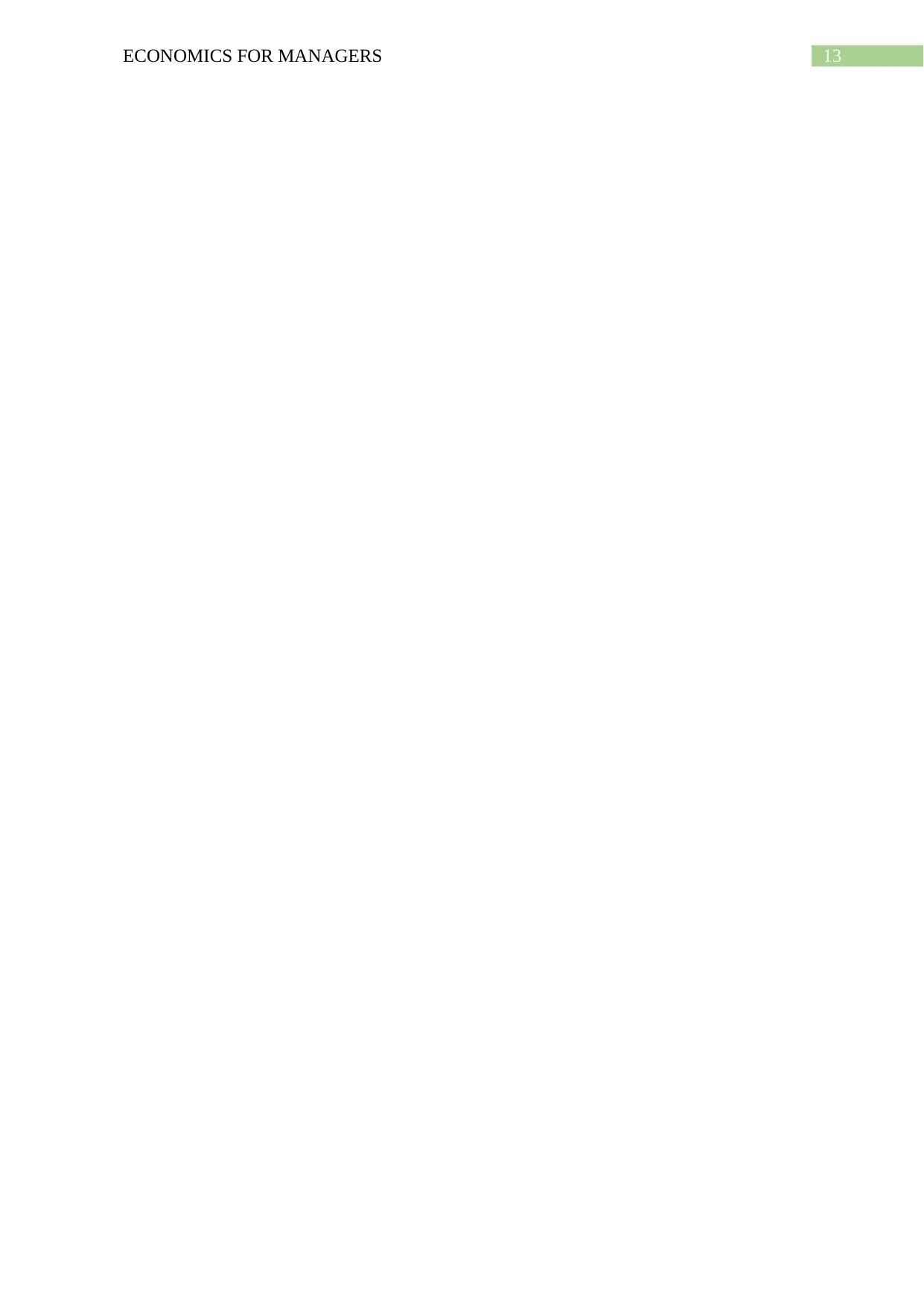
13ECONOMICS FOR MANAGERS
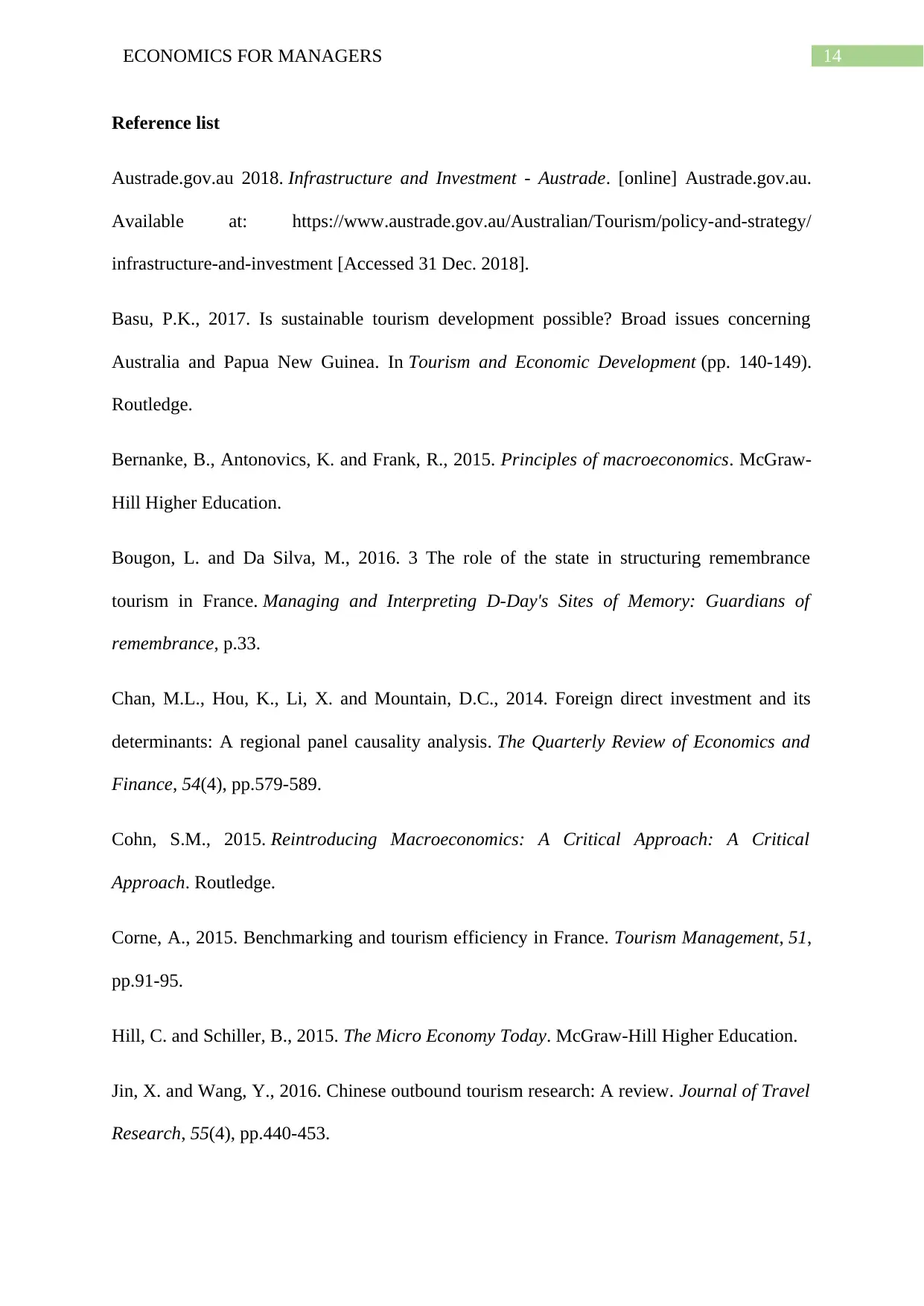
14ECONOMICS FOR MANAGERS
Reference list
Austrade.gov.au 2018. Infrastructure and Investment - Austrade. [online] Austrade.gov.au.
Available at: https://www.austrade.gov.au/Australian/Tourism/policy-and-strategy/
infrastructure-and-investment [Accessed 31 Dec. 2018].
Basu, P.K., 2017. Is sustainable tourism development possible? Broad issues concerning
Australia and Papua New Guinea. In Tourism and Economic Development (pp. 140-149).
Routledge.
Bernanke, B., Antonovics, K. and Frank, R., 2015. Principles of macroeconomics. McGraw-
Hill Higher Education.
Bougon, L. and Da Silva, M., 2016. 3 The role of the state in structuring remembrance
tourism in France. Managing and Interpreting D-Day's Sites of Memory: Guardians of
remembrance, p.33.
Chan, M.L., Hou, K., Li, X. and Mountain, D.C., 2014. Foreign direct investment and its
determinants: A regional panel causality analysis. The Quarterly Review of Economics and
Finance, 54(4), pp.579-589.
Cohn, S.M., 2015. Reintroducing Macroeconomics: A Critical Approach: A Critical
Approach. Routledge.
Corne, A., 2015. Benchmarking and tourism efficiency in France. Tourism Management, 51,
pp.91-95.
Hill, C. and Schiller, B., 2015. The Micro Economy Today. McGraw-Hill Higher Education.
Jin, X. and Wang, Y., 2016. Chinese outbound tourism research: A review. Journal of Travel
Research, 55(4), pp.440-453.
Reference list
Austrade.gov.au 2018. Infrastructure and Investment - Austrade. [online] Austrade.gov.au.
Available at: https://www.austrade.gov.au/Australian/Tourism/policy-and-strategy/
infrastructure-and-investment [Accessed 31 Dec. 2018].
Basu, P.K., 2017. Is sustainable tourism development possible? Broad issues concerning
Australia and Papua New Guinea. In Tourism and Economic Development (pp. 140-149).
Routledge.
Bernanke, B., Antonovics, K. and Frank, R., 2015. Principles of macroeconomics. McGraw-
Hill Higher Education.
Bougon, L. and Da Silva, M., 2016. 3 The role of the state in structuring remembrance
tourism in France. Managing and Interpreting D-Day's Sites of Memory: Guardians of
remembrance, p.33.
Chan, M.L., Hou, K., Li, X. and Mountain, D.C., 2014. Foreign direct investment and its
determinants: A regional panel causality analysis. The Quarterly Review of Economics and
Finance, 54(4), pp.579-589.
Cohn, S.M., 2015. Reintroducing Macroeconomics: A Critical Approach: A Critical
Approach. Routledge.
Corne, A., 2015. Benchmarking and tourism efficiency in France. Tourism Management, 51,
pp.91-95.
Hill, C. and Schiller, B., 2015. The Micro Economy Today. McGraw-Hill Higher Education.
Jin, X. and Wang, Y., 2016. Chinese outbound tourism research: A review. Journal of Travel
Research, 55(4), pp.440-453.

15ECONOMICS FOR MANAGERS
Kim, S. and Butler, G., 2015. Local community perspectives towards dark tourism
development: The case of Snowtown, South Australia. Journal of Tourism and Cultural
Change, 13(1), pp.78-89.
Mankiw, N.G., 2014. Principles of macroeconomics. Cengage Learning.
McLennan, C.L.J., Becken, S. and Moyle, B.D., 2017. Framing in a contested space: Media
reporting on tourism and mining in Australia. Current Issues in Tourism, 20(9), pp.960-980.
Moulin, H., 2014. Cooperative microeconomics: a game-theoretic introduction (Vol. 313).
Princeton University Press.
Nicholson, W. and Snyder, C., 2014. Intermediate microeconomics and its application.
Nelson Education.
Pc.gov.au 2018. Australia's international tourism industry. [online] Pc.gov.au. Available at:
https://www.pc.gov.au/news-media/pc-news/previous-editions/pc-news-may-2015/australia-
international-tourism-industry [Accessed 31 Dec. 2018].
Perri, A., 2016. Residential Roots Tourism in Italy. Second Home Tourism in Europe:
Lifestyle Issues and Policy Responses, p.53.
Rader, T., 2014. Theory of microeconomics. Academic Press.
Randle, E.J. and Hoye, R., 2016. Stakeholder perception of regulating commercial tourism in
Victorian National Parks, Australia. Tourism Management, 54, pp.138-149.
Santeramo, F.G. and Morelli, M., 2016. Modelling tourism flows through gravity models: a
quantile regression approach. Current Issues in Tourism, 19(11), pp.1077-1083.
Kim, S. and Butler, G., 2015. Local community perspectives towards dark tourism
development: The case of Snowtown, South Australia. Journal of Tourism and Cultural
Change, 13(1), pp.78-89.
Mankiw, N.G., 2014. Principles of macroeconomics. Cengage Learning.
McLennan, C.L.J., Becken, S. and Moyle, B.D., 2017. Framing in a contested space: Media
reporting on tourism and mining in Australia. Current Issues in Tourism, 20(9), pp.960-980.
Moulin, H., 2014. Cooperative microeconomics: a game-theoretic introduction (Vol. 313).
Princeton University Press.
Nicholson, W. and Snyder, C., 2014. Intermediate microeconomics and its application.
Nelson Education.
Pc.gov.au 2018. Australia's international tourism industry. [online] Pc.gov.au. Available at:
https://www.pc.gov.au/news-media/pc-news/previous-editions/pc-news-may-2015/australia-
international-tourism-industry [Accessed 31 Dec. 2018].
Perri, A., 2016. Residential Roots Tourism in Italy. Second Home Tourism in Europe:
Lifestyle Issues and Policy Responses, p.53.
Rader, T., 2014. Theory of microeconomics. Academic Press.
Randle, E.J. and Hoye, R., 2016. Stakeholder perception of regulating commercial tourism in
Victorian National Parks, Australia. Tourism Management, 54, pp.138-149.
Santeramo, F.G. and Morelli, M., 2016. Modelling tourism flows through gravity models: a
quantile regression approach. Current Issues in Tourism, 19(11), pp.1077-1083.
Secure Best Marks with AI Grader
Need help grading? Try our AI Grader for instant feedback on your assignments.

16ECONOMICS FOR MANAGERS
Sinclair-Maragh, G., Gursoy, D. and Vieregge, M., 2015. Residents׳ perceptions toward
tourism development: A factor-cluster approach. Journal of Destination Marketing &
Management, 4(1), pp.36-45.
statista.com 2017. Topic: Tourism industry in China. [online] www.statista.com. Available
at: https://www.statista.com/topics/1210/tourism-industry-in-china/ [Accessed 31 Dec. 2018].
Vanhove, N., 2017. The Economics of Tourism Destinations: Theory and Practice.
Routledge.
Wttc.org 2018. TRAVEL & TOURISM ECONOMIC IMPACT FRANCE. [online] Wttc.org.
Available at: https://www.wttc.org/-/media/files/reports/economic-impact-research/countries-
2017/france2017.pdf [Accessed 31 Dec. 2018].
Zhao, S.N. and Timothy, D.J., 2015. Governance of red tourism in China: Perspectives on
power and guanxi. Tourism Management, 46, pp.489-500.
Sinclair-Maragh, G., Gursoy, D. and Vieregge, M., 2015. Residents׳ perceptions toward
tourism development: A factor-cluster approach. Journal of Destination Marketing &
Management, 4(1), pp.36-45.
statista.com 2017. Topic: Tourism industry in China. [online] www.statista.com. Available
at: https://www.statista.com/topics/1210/tourism-industry-in-china/ [Accessed 31 Dec. 2018].
Vanhove, N., 2017. The Economics of Tourism Destinations: Theory and Practice.
Routledge.
Wttc.org 2018. TRAVEL & TOURISM ECONOMIC IMPACT FRANCE. [online] Wttc.org.
Available at: https://www.wttc.org/-/media/files/reports/economic-impact-research/countries-
2017/france2017.pdf [Accessed 31 Dec. 2018].
Zhao, S.N. and Timothy, D.J., 2015. Governance of red tourism in China: Perspectives on
power and guanxi. Tourism Management, 46, pp.489-500.
1 out of 17
Related Documents
Your All-in-One AI-Powered Toolkit for Academic Success.
+13062052269
info@desklib.com
Available 24*7 on WhatsApp / Email
![[object Object]](/_next/static/media/star-bottom.7253800d.svg)
Unlock your academic potential
© 2024 | Zucol Services PVT LTD | All rights reserved.





